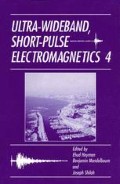Abstract
A problem of interest concerns compact, high power ultra-wideband systems which minimize the volume of high pressure gas. Thus, single channel spark gaps are considered because the volume of gas under pressure is much less than that needed for sources containing ring gap switches. However, the intrinsic inductance of single channel spark gaps is prohibitively high to achieve large rates of voltage rise.
For future applications, the limit of spark gap technology for ultrafast switching is explored. Specifically, an estimate of the fastest risetime achievable with a single channel spark gap has been investigated using three approaches. The first examines the growth of the electron avalanche in gases to estimate its growth rate. The avalanche growth rate determines the fastest possible risetime of the resultant pulse. The second approach uses the components of the velocity of electromagnetic propagation to estimate the achievable risetime. The third uses an equivalent circuit of a single channel spark gap to calculate the maximum achievable rate of voltage rise. The first two estimates indicate that risetimes on the order of 1–10 ps are achievable. The last treatment, however, illustrates the dependence of the pulse risetime on the peak voltage and calculates the maximum rate of voltage rise to be on the order of 1016 V/s.
To reduce the effect of the intrinsic inductance of the channel, a simple geometrical alteration to the spark gap geometry has been devised which effectively reduces the inductance per unit length of the spark gap to that of its transmission line feed. This simple change alleviates the constraint imposes by the maximum rate of voltage rise and is anticipated to permit the realization of picosecond risetime high power electromagnetic sources.
Access this chapter
Tax calculation will be finalised at checkout
Purchases are for personal use only
Preview
Unable to display preview. Download preview PDF.
References
W.D. Prather, C.E. Baum, F.J. Agee, J.P. O’Laughlin, D.W. Scholfield, J.W. Burger, J. Hull, J.S.H. Schoenberg, and R. Copeland, “Ultrawide Band Sources and Antennas: Present Technology, Limitations, Future Challenges,” pp. 381–389 in Ultra Wideband/Short Pulse Electromagnetics 3, C.E. Baum, et.al (eds.), Plenum Press, New York, 1996.
J.P. O’Laughlin and R.P. Copeland, “Subnanosecond Power Conditioning Technique Using Transmission Line to Transmission Line Charging,” Proc. 20th Power Modulator Symposium, pp. 351–354, 1992.
E.A. Avilov and N.V. Belkin, “Electrical Strength of Nitrogen and Hydrogen at High Pressures,” Sov. Phys. Tech. Phys., Vol. 19, No. 12, June 1975.
C A. Frost, T.H. Martin, P. E. Patterson, L.F. Rinehart, G.J. Rohwein, L.D. Roose, J.F. Aurand, M.T. Buttram, “Ultrafast Gas Switching Experiments,” Proc. 9th IEEE Pulsed Power Conference, K. Prestwich and W. Baker, Eds., pp. 491–494, 1993.
R.E. Cassell and F. Villa, “High Speed Switching in Gases,” SLAC Publication 1858, February, 1989.
S. Levinson, E.E. Kunhardt and M. Kristiansen, “Simulation of Inductive and Electromagnetic Effects Associated with Single and Multichannel Triggered Spark Gaps,” Proc. 2nd IEEE Pulsed Power Conference, A.H. Guenther and M. Kristiansen, Eds., pp. 433–436, 1979.
Author information
Authors and Affiliations
Editor information
Editors and Affiliations
Rights and permissions
Copyright information
© 2002 Kluwer Academic Publishers
About this chapter
Cite this chapter
Lehr, J.M., Baum, C.E., Prather, W.D., Torres, R.J. (2002). Fundamental Physical Considerations for Ultrafast Spark Gap Switching. In: Heyman, E., Mandelbaum, B., Shiloh, J. (eds) Ultra-Wideband Short-Pulse Electromagnetics 4. Springer, Boston, MA. https://doi.org/10.1007/0-306-47093-4_2
Download citation
DOI: https://doi.org/10.1007/0-306-47093-4_2
Publisher Name: Springer, Boston, MA
Print ISBN: 978-0-306-46206-1
Online ISBN: 978-0-306-47093-6
eBook Packages: Springer Book Archive

